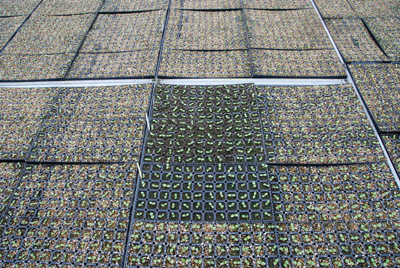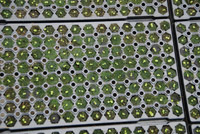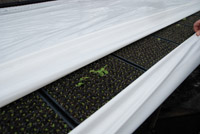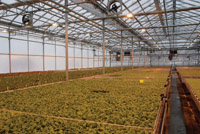
Features
Crop Culture
Inputs
Growing in the Green: It’s time for a tune-up
September 29, 2010 By Melhem Sawaya
During preparations for every seasonal crop, a series of steps are
required before the actual production phase. These steps are commonly
called the “tune-up.”
During preparations for every seasonal crop, a series of steps are required before the actual production phase. These steps are commonly called the “tune-up.”
 |
|
| Should I cover my plugs or not – trying it for yourself is the only answer. Advertisement
|
We send our cars for a checkup before a long trip or during intervals of every so many kilometres. Athletes check their equipment before a match, whether it’s their rackets, bows or skates, etc.
I worked on a farm for a couple of years and my boss, Mr. Freeman, would always stress the need to get the machinery well-tuned well ahead of field work for two reasons:
- It takes much longer to fix machinery after it breaks than a preventive tune-up, not to mention how inconvenient and frustrating it is to deal with equipment that has broken down when you need it most.
- Time and schedules must be met or the crop will suffer. Even in field production, you have a narrow window of opportunity for planting or harvesting. At the farm I worked at, there was a very narrow window for planting. One day it might be too wet, the next day would be perfect, and the third day would be too dry. You guessed it – we worked on clay fields!
But the timing window for plug production is just as narrow, and the preparations should be completed well in advance of actual production. Some of the things to check include the seeder, germination chamber, mist lines, flat fillers, and seed storage area. (Hopefully you have a suitable storage area by now and are not storing seeds in your desk.) You should also conduct a practice run with some seeds to check the entire process. And most importantly, check to ensure your staff is ready and well trained.
The most important aspect of greenhouse profitability is having no shrinkage!
This is not just about heating costs, labour efficiency or low prices, though these would all be factors with profitability. But compared to shrinkage, they are minor costs.
IF YOU GROW YOUR OWN PLUGS…
■ Here are some pointers to help with a plug production tune-up and during the actual production.

|
|
| Using large plugs with a slow growing variety is a recipe for algae.
|
SEED: The storage of seeds is very important. Do not open the container until you are ready to sow, and hopefully you will use it all. If you don’t need a large order, use several smaller packages.
Using leftover seed from the previous year is often a waste of time. Sow a small sample of it to give you a good idea of whether it is viable or not. Some seed stores better than others.
MEDIA: For optimum seed germination and growth, a proper pH of 5.7 to 6.2 is a must.
Soluble salts should be in the 0.4-0.8 range, a 2:1 dilution.
Sodium and chloride levels should each be less than 40 ppm.
Phosphorus levels should be in the 8-10 ppm range, or else the plugs will be completely stunted.
Good holding capacity is essential. The most important factor of plug production is testing the media in-house and at a lab before any seeding is done, to see if the pH, soluble salts and other nutrients are within the optimal ranges. About 90 per cent of plug problems are related to pH and soluble salt issues.
FLATS AND FLAT FILLING: The physical properties of plug flats are also important. The deeper the cell, the better it is for drainage due to the deeper columns.
Filling the flats evenly with the same density throughout the whole flat is also important to ensure uniform moisture levels during the plug-growing period.
A QUICK WAY TO CHECK SOIL MOISTURE LEVELS
■ The soil should be damp to the touch but not dripping wet. One way to check moisture content of the plug media is by taking a handful of the mix after wetting and then squeezing it. If it drips, it is too wet. If it crumbles, it is too dry. But if it stays in one clump, then it is the right degree of wetness.
SOWING: Adjust your seeder so that there are no misses. Maybe it is time to change nozzles, check the drum or have a simple tune-up.
Pay attention to seed placement. Seeds placed near the edge of the cavity could desiccate, especially when we are trying to run the crop on the drier side.

|
|
| Begonia started under plastic.
|
If you are covering seed, never use fine vermiculite. The idea is to create a microenvironment of high humidity, not to bury the seed. Use of medium vermiculite of proportionally sized particles is recommended; do not use the dusty leftover vermiculite.
If plug flats are passed through a watering tunnel, make sure the flats are evenly watered with gentle irrigation so the seed is not buried. This is especially important with very small seed.
Sown plug flats should not sit in the growing area for too long, because the minute the germination process starts, it should not be interrupted by a drying period. It is very important to sow the plug flats and have them immediately moved into the germination chamber or propagation area to receive the humidity or water cycles as required.
Sown plug flats should be transported to the propagation area without being severely shaken, as this might bury the seeds more than is desirable.
FERTILIZATION: Plugs need to be fertilized at early stages, but at a low EC level of 0.75 mmhos of total water and fertilizer. This is a recommended starting point, assuming we are starting with a low EC plug media.
Avoid the use of high ammonium fertilizers, especially early in the season when light levels are low. As well, the use of ammonium fertilizers is not recommended if you are trying to cool the plugs.
REGULARLY CHECK PHOSPHORUS LEVELS
■ Many plug nutrition articles recommend you not fertilize with high phosphorus levels. The emphasis with this recommendation should be on the “high” rather than the “not.” Maintaining low levels of phosphorus in plug media is as important as any other element. A phosphorus level of 8-10 ppm in the plug media is important in the energy compounds, such as ATP, that the plant needs for synthesis and degradation. At the same time, high levels of phosphorus will cause plug stretch and inhibit the absorption of copper, iron, zinc and boron.
In simple words, moderation is the key. Test your media frequently to know your levels.
 |
|
| Gerbera plugs grown properly under high intensity lights and long days. |
PLUG STAGES: Adjust the environment and treatments to support every plug stage. Do not treat all stages and seeds the same, because they are not. The KISS (Keep It Simple, Silly) theory has limits before negative consequences occur.
GROWTH REGULATORS: Many methods can be used to regulate growth, but with our low light levels early in the season, we depend more on chemical growth regulators. Pick the right growth regulator and the right rate to use on your plugs.
The rate and type of growth regulator to use varies with:
- Temperature – higher temperatures require higher rates.
- Light levels – the higher the light levels, the lower the amount of growth regulators needed, especially if that crop, (geraniums, for example) flowers with accumulated light levels.
- The type of grower you are – wet grower or dry grower.
- Greenhouse environment – glass versus poly.
- Humidity – greenhouses with high humidity require higher rate of growth regulators.
- Cultivars within the same genus require different rates, for example red petunia vs. purple.
- Varietal selection will determine the rate of growth regulator to use, for example Easy Wave Petunia vs. Purple Wave Petunia.
- The rate changes with a grower’s way of applying the growth regulators – light vs. heavy spraying; that’s why we should spray with a pre-determined volume per area.
- Plant condition when spraying – if the leaves are wet, then the rate has much less effect, if any.
- With all these variables in mind, the only way to know what rates to use is by doing your own trials based on recommended rates and judge for yourself.
Please note: Many of the label recommendations are based on very hot and sunny conditions, so the rates will be too high for Canada and northern states.
IF YOU PURCHASE YOUR PLUGS…
■ The previous steps are more applicable if you propagate your own plugs. Here are some guidelines if you purchase plugs:
- Make sure you calculated your growing correctly, and don’t try to grow that extra 5-10 per cent. This will put the rest of the production into a squeeze and will definitely cause a reduction in efficiency and quality.
- Plan for the plugs to arrive on the week you are planting, and not a week earlier. That extra week will spin into diminished quality. It will increase the risk of losing them simply from over-watering or, more likely, forgetting to water them for a day.
- Plant the same week you receive the plugs. Don’t postpone planting due to shipping issues or any other reason. Anything not done correctly during planting will have a negative impact when shipping.
- Calculate your labour capacity on how much you can plant in any specific week, and order only the amount of plugs that you are able to use in that period. Ordering based on a plan different than the growing schedule is only a good idea if you plant on time and space on time.
- Make sure you do not program your plugs to finish at one date if you know you will not sell them all in that week.
- Heat-loving crops are seriously delayed if planted when outdoor temperatures are still below 16-17℃.
- Order plugs to extend the season, but in moderation and only if you have a home for them.
- Only grow what is ordered; you know from sales history what you can sell.
- Grow varieties that will perform well in the garden. If we do not care for garden performance, we better invest in sod farms or, more likely, concrete or asphalt contracting companies, because consumers won’t return if you grow varieties that don’t perform well year after year. This is the main reason we started the Sawaya Garden Performance Trials. They ensure we can deliver cultivars that will flourish in our climate and give the consumer a satisfying gardening experience.
In next month’s article, I will summarize this summer’s trials. ■
Melhem Sawaya of Focus Greenhouse Management is a consultant and research coordinator to the horticultural industry. Comments on this or any other article are always welcome; please e-mail mel@focusgreenhousemanagement.com, or visit www.focusgreenhousemanagement.com or www.sawayagardentrials.ca.
Print this page